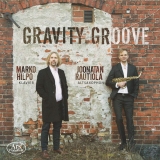 Gravity Groove; Claude Debussy: Rhapsodie; Tuomas Turriago: Sonate Gravity Groove; Paule Maurice: Tableaux de Provence; Charles Wuorinen: Divertimento; Wolfgang A. Mozart: Trio KV 498 Kegelstatt; Joonatan Rautiola, Saxophon, Marko Hilpo, Klavier, Barbora Hilpo, Viola; 1 CD Ars Produktion 38569; Aufnahme 2018, Veröffentlichung 04/2021 (o. A.) – Rezension von Remy Franck
Gravity Groove; Claude Debussy: Rhapsodie; Tuomas Turriago: Sonate Gravity Groove; Paule Maurice: Tableaux de Provence; Charles Wuorinen: Divertimento; Wolfgang A. Mozart: Trio KV 498 Kegelstatt; Joonatan Rautiola, Saxophon, Marko Hilpo, Klavier, Barbora Hilpo, Viola; 1 CD Ars Produktion 38569; Aufnahme 2018, Veröffentlichung 04/2021 (o. A.) – Rezension von Remy Franck
Viele verschiedene Facetten des Saxophons kann man auf dieser CD entdecken. Da ist zunächst Debussys Rhapsodie aus dem Jahre 1908, die aus einer sensuellen nächtlich-schwülen Stimmung aufschwingt, dann Turriagos farbige Sonate, die tonmalerische Suite Tableaux de Provence der französischen Komponistin Paule Maurice (1910-1967), Charles Wuorinens Bearbeitung seines Streichquartett-Divertimentos für Altsaxophon und Klavier und Mozarts Kegelstatt-Quartett, in der für einmal das Saxophon die Klarinette ersetzt.
Der Finne Joonatan Rautiola am Saxophon und Marko Hilpo am Klavier überzeugen mit exzellenten, stimmungsvollen Darbietungen.
Rautiola beeindruckt vor allem mit einem Spiel, das durchs ganze Programm hindurch Leichtigkeit und Sanftheit ausbalanciert, bewundernswert bedient durch das warme, oft weiche Timbre des Altsaxophons. Man bewundert auch die subtile Farbgebung, sowie, in den schnellen Sätzen, das virtuose Talent des Saxophonbisten in einem lebendigen und beredten Dialog mit dem Klavier.
Many different facets of the saxophone can be discovered on this CD. First there is Debussy’s Rhapsody from 1908, which soars from a sensual nocturnal mood, then Turriago’s colorful Sonata, the atmopsheric suite Tableaux de Provence by the French composer Paule Maurice (1910-1967), Charles Wuorinen’s arrangement of his String Quartet Divertimento for alto saxophone and piano, and Mozart’s Kegelstatt Quartet, in which for once the saxophone replaces the clarinet.
The Finn Joonatan Rautiola on saxophone and Marko Hilpo on piano convince with excellent, atmospheric performances.
Rautiola impresses above all with playing that balances lightness and gentleness throughout the program, admirably served by the warm, often soft timbre of the alto saxophone. One also admires the subtle coloring, as well as, in the fast movements, the saxophonist’s virtuosic talent in a lively and eloquent dialogue with the piano.






















